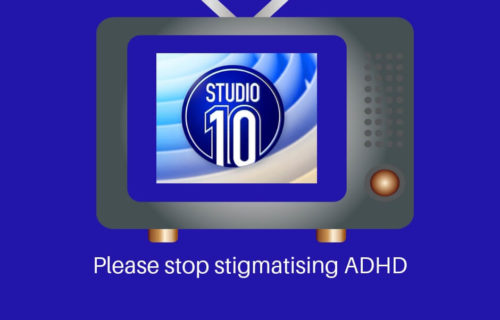
R U OK? It’s time to include people with ADHD!
Most individuals who have ADHD, whether they are kids, teenagers or adults, feel misunderstood. We also feel the judgement, misunderstanding, and stigma surrounding our disorder.
This stigma hurts – more than you will probably ever know.
It’s also extremely dangerous.
A recent systematic review reported that community attitudes towards children and adults with ADHD tend to be negative. They also found that adults tend to believe ADHD is over-diagnosed and are uncertain about the use of ADHD prescription medication, despite evidence-based clinical guidelines guiding the diagnosis and treatment of ADHD. Many adults also incorrectly attribute the symptoms displayed by children with ADHD to TV/internet exposure, lack of parental affection, being from a broken home, etc.
These findings are really concerning as the impact of other people’s negative attitudes has a devastating impact upon children and adults living with ADHD and their families.
Studies tell us that young people are aware that others view them in a negative light and that they commonly feel different, devalued, embarrassed, inadequate, and incompetent. Parents have reported that their children express self-loathing, with some stating they want to die.
We also know that mothers of children with ADHD are at high risk of developing depression and/or anxiety due to the stigma surrounding ADHD and that this stigma can not only influence the way they perceive their child but also influence whether they will decide to have their child assessed for the disorder. Furthermore, it can lead to parents underestimating the risks associated with poorly treated ADHD, muddy the truth around best practice evidence-based treatment options and interfere with decision-making, and affect treatment adherence and efficiency.
In adulthood, people with ADHD tend to report low levels of self-esteem, self-efficacy, mental wellbeing, and quality of life satisfaction and enjoyment (Barkley, 2015; Barkley & Fischer, 2019). Two systematic reviews have concluded that adults who identify as having ADHD generally exhibit lower global self-esteem relative to healthy controls, regardless of gender (Cooke et al, 2014; Harpin et al., 2016), and the suicide rate for people with ADHD is 10 times higher than in the general population.
Why does stigma still exist
One reason is because ADHD is a very complex neurological disorder that is very difficult to understand. People with ADHD struggle with things that come naturally to the vast majority of the population, therefore, there is a tendency to presume that ADHD symptoms result from a character flaw such as selfishness or laziness, rather than significant differences in brain anatomy and functional processing. ADHD symptoms also tend to manifest in ways that can be considered annoying or socially inappropriate. Furthermore, children and adolescence with the disorder can develop disruptive and delinquent behaviour, particularly if they do not receive the treatment and support they need.
Another reason is that it’s not uncommon for well-meaning researchers to release media statements that unwittingly stigmatise members of the ADHD community. The media then inflates or sensationalises these statements and runs with them.
Take the slew of recent media articles on the paper titled: Overdiagnosis of Attention-Deficit/Hyperactivity Disorder in Children and Adolescents: A Systematic Scoping Review (purposefully not linked).
The authors of this systematic scoping study make a number of claims, especially in the media, that feed into the fear and stigma surrounding ADHD. For example, the authors state they found evidence indicating ADHD diagnosis rates have increased in 45 studies, and that 83 studies indicate pharmacological treatment of ADHD is increasing. They then infer that these findings provide evidence of ADHD overdiagnosis and overtreatment in children and adolescents. The study methods employed in their review, however, were inconsistent and the authors did not clarify the evidence establishing increased diagnosis and pharmacology prescription rates equate to overdiagnosis of ADHD. Without providing this evidence, which does not exist, the link is purely speculative.
Furthermore, if ADHD diagnosis and medication administration rates are starting to align with the predicted prevalence rates of ADHD (see below), we could equally argue that it’s time to celebrate as it would mean the available evidence-based clinical practice guidelines and health literacy initiatives that have been implemented worldwide are finally achieving their desired results – ensuring people with ADHD receive the treatment and support they need.
The study identified 31 papers that reported on the consequence of an ADHD diagnosis. Out of the 31, only two papers speculated that there is a potential for ADHD diagnosis to contribute to adverse social, psychological, and academic outcomes in children with mild ADHD symptoms. The authors, however, chose to report on these possible negative consequences while ignoring the benefits of diagnosis reported in the other 29 papers. Furthermore, the speculated adverse outcomes the authors identified were related to the stigma surrounding ADHD, yet they went on to make statements in the media that are only going to further perpetuate this stigma.
Other problematic assertions made by the authors that rely on the underlying premise on which they are based to be true (yet no evidence is provided to substantiate their claims) include:
- only a small proportion of all diagnosed youths display severe ADHD behaviours equates to children with mild ADHD symptoms being unnecessarily diagnosed
- increasing diagnostic rates in youth from various migrant backgrounds equates to actual overdiagnosis of children in these communities
- diagnostic variations due to socioeconomic or health insurance status equates to overdiagnosis in higher socioeconomic region
- the potential for overdiagnosis equates to actual overdiagnosis.
So is there evidence of ADHD overdiagnosis in Australia?
ADHD is thought to affect approximately 5-6% of children worldwide. Therefore, we should expect to see Australian ADHD administrative prevalence rates (or the number of children and adolescents diagnosed with ADHD) to sit between 5-6%. If Australian ADHD administrative prevalence rates sit below the expected ADHD prevalence rate this would indicate there is evidence of under-diagnosis, if they sit above this rate then there is evidence of overdiagnosis.
How was the worldwide ADHD prevalence rate determined?
Predicted worldwide ADHD prevalence rates are based on findings from a number of high-powered systemic review and meta-analysis studies. These studies encompassed a substantial number of carefully conducted epidemiology studies. The most significant meta-analysis study also underwent complex meta-regression analysis. For example, a 2012 systematic review incorporating 102 studies and 171,756 participants reported that the worldwide prevalence rate for ADHD in children sits at around 5.29% (Polanczyk et al., 2007). A meta-analysis of 19 studies with over 55,000 participants conducted in 2012 reported 5.9% of youths meet the diagnostic criteria for ADHD (Willcutt, 2012). It is important to acknowledge ADHD prevalence rates have been reported to be relatively stable worldwide over the last three decades when consistent study methods are employed.
How many children & adolescents in Australia have been diagnosed with ADHD?
In 2019, Deloitte Access Economics estimated the administrative ADHD prevalence rate (or the number of children and adolescence diagnosed in ADHD in Australia) to be 4.2% for children aged 0-14 years and 5.6% for adolescents aged 15-19 years.
Is ADHD over-diagnosed in children & adolescents in Australia?
The Australian ADHD administrative prevalence rates (or diagnosis rates) for children between 0-14 years sit below the expected worldwide prevalence rates. This indicates that there is no evidence to show ADHD is overdiagnosed in Australia in this group of children.
The Australian ADHD administrative prevalence rate for adolescents aged 15-19 years aligns with the expected worldwide prevalence rate. This indicates that the number of adolescents diagnosed with ADHD in Australia aligns with evidence-based expectations and, therefore, there is no evidence of over diagnosis.
Please do not confuse US administrative prevalence rates with Australian rates
A 2016 study by the US Centers for Disease Control and Prevention estimated the US administrative ADHD prevalence rate to be 9.6% in young children aged 5-11 years and 13.6% in adolescents aged 12-17 years. These findings indicate that it is highly likely ADHD is overdiagnosed in the US.
Australia is not at risk of ending up with similar administrative ADHD prevalence rates. In Australia, an ADHD diagnosis is only made after a comprehensive medical, developmental, and mental health review, and the findings have to meet the Diagnostic and Statistical Manual of Mental Disorders ADHD criteria. Stimulant medication is also tightly controlled by the Health Department in each state and territory.
Why is putting an end to the stigma surrounding ADHD so important?
Copious studies show ADHD is a risk factor for adverse outcomes such as poor academic achievement; anti-social behaviour, social rejection, and isolation; relationship dysfunction; mental health disorders (anxiety and depression, alcohol/substance abuse, eating disorders); accidents and injuries; criminality; self-harm and suicide; and other adverse long-term health outcomes which can reduce life expectancy. Additionally, adults with ADHD tend to report low levels of self-esteem, self-efficacy, mental wellbeing and quality of life satisfaction and enjoyment. Therefore, our priority should be to prevent these adverse outcomes by ensuring children with ADHD are appropriately diagnosed and treated so they mature in a healthy manner, live full and rewarding lives, and thrive.
RUOK?
Stigmatising a disorder and placing a group at risk of mental health challenges is the direct opposite of the intention of the government’s preventative health strategy. If this was any other mental health condition, would we stand for this? I don’t think so.
R U OK includes ADHD.
Please play your part in reducing the stigma surrounding ADHD so that together we can improve the lives of 850,000 Australians living with the disorder.




Add A Comment